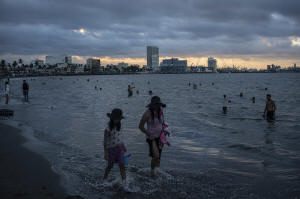Mexico study's surprising finding: Killer heat hit harder for the young
than the elderly
 Send a link to a friend
Send a link to a friend
 [December 07, 2024]
By SETH BORENSTEIN [December 07, 2024]
By SETH BORENSTEIN
A surprising study of temperature-related deaths in Mexico upends
conventional thinking about what age group is hit hardest by heat.
Researchers found at higher temperatures and humidity, the heat kills
far more young people under 35 than those older than 50.
For decades, health and weather experts have warned that the elderly and
the youngest children were most vulnerable in heat waves. But this study
looking at all deaths in Mexico from 1998 to 2019 shows that when the
combination of humidity and temperature reach uncomfortable levels, such
as the mid to upper 80s Fahrenheit (around 30 degrees Celsius) and 50%
relative humidity, there were nearly 32 temperature-related deaths of
people 35 years old for every temperature-related death of someone 50
and older.
The study in Friday's journal Science Advances shows an especially
surprising spike of heat-related deaths in an age group thought to be
young and robust: People between 18 and 35. That age group alone had
nine times as many temperature-related deaths as those older than 50.
Study authors and outside experts are scrambling to figure out why.
Demographics alone don't explain why more young adult Mexicans are dying
in high heat than their elders. Two theories: Outdoor workers who can't
escape the heat, and young people who don't know their limits.
The trend is likely to widen as the world warms from human-caused
climate change, according to computer simulations run by the study team.

“We found that younger people are especially vulnerable to humid heat,”
study co-author Jeffrey Shrader, a climate economist at Columbia
University, said. “As the climate warms, we're really going to be
shifting the burden of temperature-related mortality towards younger
individuals and away from older individuals who tend to be more
vulnerable to cold temperatures.”
Data from cold weather shows more than 300 deaths of Mexican residents
50 and older for every young person dying from cold temperatures,
according to the study.
“People of all ages are increasingly at risk from the rising
temperatures, and this study shows that those that we might have
considered relatively safe from heat-related adverse health outcomes
might not be so much so,” said Marina Romanello, executive director of
the Lancet Countdown that monitors health effects of climate change. She
was not part of the study team.
“Heat is a much more dangerous silent killer than most people
acknowledge it to be, and that heat is increasingly putting our health
and survival at risk," Romanello said in an email.
Study authors decided to examine weather-related deaths in Mexico
because that country not only has detailed mortality data, but it has a
variety of different climates making it an ideal place to study in
depth, Shrader said.
Researchers also want to figure out whether this is just a situation in
Mexico or other warmer sections of the globe have similar spikes in
young adult deaths in high heat and humidity.
[to top of second column]
|

A woman and a girl walk along the shore to cool off during a heat
wave on the coast of Veracruz, Mexico, on June 15, 2024. (AP
Photo/Felix Marquez, File)
 Initially the team just wanted to
look at deaths and what scientists call wet-bulb globe temperatures,
but when they looked at age differences, they were surprised and
looked in more detail, Shrader said. Wet-bulb temperature, which is
intended to mirror how the body cools itself, is derived using a
complicated measurement system that factors in humidity and solar
radiation. A wet-bulb globe temperature of 35 degrees Celsius (95
degrees Fahrenheit) is thought to be the limit for human
survivability. Most places don’t reach that level.
Researchers determined temperature-related mortality by complex
statistical analysis that compares numerous factors in the number of
deaths and removes everything they can except temperature
fluctuations, said study co-author Andrew Wilson, a Columbia climate
economics researcher.
Researchers also calculated the ideal temperature for when there are
the fewest excess deaths at each age group. Younger adults' sweet
temperature spot is about nine degrees Fahrenheit (five degrees
Celsius) cooler than it is for older people, Shrader and Wilson
said.
Some outside health and climate experts were initially puzzled at
the higher youth mortality seen in the study. Co-author Patrick
Kinney, a professor of urban health and sustainability at Boston
University, said it was likely the study included a higher
proportion of outdoor workers exposed to heat than prior studies
did.
Study co-author Tereza Cavazos, a climate scientist at the Ensenada
Center for Scientific Research and Higher Education in Mexico, said
she remembers her father's generations taking siestas in the high
heat of the day and that was healthy. That doesn't happen so much
now, she said.
“There is a lot of population that is vulnerable in the future. Not
even in the future, right now,” Cavazos said. She mentioned three
Mexican heat waves this year that hit in the middle of the country
and kept the deadly heat going overnight so people had little
relief. Usually cool nights allow a body to recover.
Younger people often have a sense of invulnerability to weather
extremes and do things that increase their risk, such as play sports
in high heat, Cavazos said.
“High humidity makes it a lot harder for the body to cool itself
through sweating – which is how our body primarily stays cool," said
Dr. Renee Salas, an emergency medicine physician and climate change
expert at Massachusetts General Hospital and Harvard Medical School.
She was not part of the study team. "So someone young and healthy
working outside in heat and high humidity can reach a point where
the body can no longer cool itself safely – causing a deadly form of
heat injury called heat stroke.”
All contents © copyright 2024 Associated Press. All rights reserved
 |